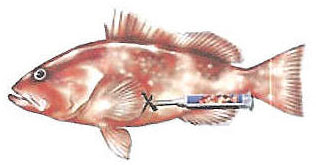HOW TO PROPERLY RELEASE DEEP WATER SPECIES
Since red snapper will soon be completely off limits for offshore fishermen and have to be released back to the water. There’s been a lot of controversy about releasing undersized and off-limits snapper. Many fishermen believe that most of the released snapper do not survive. And that’s a fact because many of the fish especially those brought up in deeper waters simply flounder on the surface and become an easy meal for predators. It’s not certain how many of those after being unhooked and swim off actually survive. Red snapper are by far not the only “reef” species with minimum size and bag limits. In fact most offshore species currently have limits and it’s the responsibility of offshore anglers to carefully handle fish to be released in order to maintain healthy and properly managed fish populations.
The problem with reef fish is that many have a gas-filled organ known as a “swimbladder.” It controls buoyancy and allows the fish to maintain a certain depth. When brought in quickly from deep water to shallow-water pressure changes and the gas over expands within the bladder sometimes causing it to burst. When this happens, gases continue to expand throughout the body and can push the stomach out of the mouth and the intestines out of the anus. This causes buoyancy problems leaving the fish unable to swim down to safe habitat and stranded on the surface exposed to predators.
Venting these gases from the body cavity allows the fish to swim normally. It also will allow the organs return to their normal positions as the internal pressure is relieved.
 It’s best to vent the fish as quickly as possible with a minimum of handling. As often is the case, when the stomach is extended through the mouth it shouldn’t be forced back into the body. It will return to its normal position with in a few hours after venting. To vent a fish, hold it firmly on its side and insert the venting tool at a 45-degree angle one to two inches from the base of the pectoral (or side) fin. A venting tool can be any HOLLOW, sharpened instrument that allows gases to escape. There are some commercial venting tools available or a hypodermic needle modified to allow gases to escape works well. Be sure to cap or cork the tip of the tool to prevent personal injury. Chlorine bleach is a good disinfectant between uses. Insert the tool only deep enough to release the gases. The sound of escaping gas can be heard and deflation will be noticeable. If a fish is extremely bloated, use your free hand to gently exert pressure on the abdomen to aid deflation. The everted stomach should not be punctured. The fish should be released by pointing its head downward and moving the fish back and forth over the gills until the fish swims away on its own.
It’s best to vent the fish as quickly as possible with a minimum of handling. As often is the case, when the stomach is extended through the mouth it shouldn’t be forced back into the body. It will return to its normal position with in a few hours after venting. To vent a fish, hold it firmly on its side and insert the venting tool at a 45-degree angle one to two inches from the base of the pectoral (or side) fin. A venting tool can be any HOLLOW, sharpened instrument that allows gases to escape. There are some commercial venting tools available or a hypodermic needle modified to allow gases to escape works well. Be sure to cap or cork the tip of the tool to prevent personal injury. Chlorine bleach is a good disinfectant between uses. Insert the tool only deep enough to release the gases. The sound of escaping gas can be heard and deflation will be noticeable. If a fish is extremely bloated, use your free hand to gently exert pressure on the abdomen to aid deflation. The everted stomach should not be punctured. The fish should be released by pointing its head downward and moving the fish back and forth over the gills until the fish swims away on its own.
Here is a fish survival guideline that apply not only to offshore species but also for inshore fish recommended by the NOAA Office of Sea Grant Center for Fisheries Enhancement:
- Have a plan for releasing a fish before landing it. Because time is crucial in keeping a released fish alive, work quickly and in concert with others on board for quick releases.
- Avoid using gaffs and landing nets if possible.
- Handle the fish as little as possible and try to keep the fish in the water.
- Handle the fish with wet hands, wet gloves or a wet towel to avoid removing the beneficial fish slime and be sure to avoid damaging the gills and eyes.
- Back out hooks using pliers or cut the leader as close to the hook as possible on throat-hooked fish. Use hooks that rapidly degrade in saltwater.
- Revive an exhausted fish in the water by passing water over the fish’s gills by using a gentle back and forth motion until the fish recovers enough to swim away on its on.